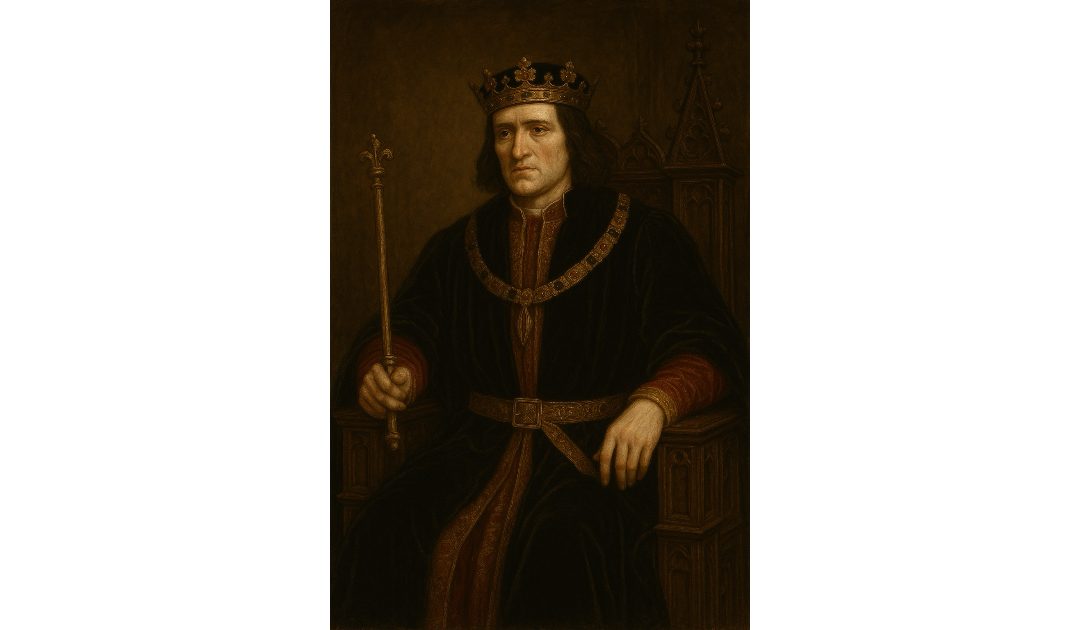On the 26th of June, 1483, Richard III became King of England. Richard III, the last Plantagenet King of England, remains one of the most controversial figures in British history. Born on the 2nd of October, 1452, his reign from 1483 until his death at the Battle of Bosworth Field in 1485 marked the culmination of the Wars of the Roses. Richard’s legacy has been heavily influenced by historical accounts and dramatic portrayals, particularly William Shakespeare’s depiction of him as a malevolent, hunchbacked villain. However, modern historians have sought to reassess Richard’s life, reign, and character, questioning whether he was truly the tyrant of Tudor propaganda or a misunderstood ruler.
Richard was the eleventh of twelve children born to Richard, Duke of York, and Cecily Neville. His formative years were shaped by the tumultuous backdrop of the Wars of the Roses, a dynastic struggle between the houses of York and Lancaster. After his father’s death at the Battle of Wakefield in 1460, Richard and his brother George were placed under the care of their cousin, Richard Neville, known as the “Kingmaker.”
Richard’s loyalty to his elder brother, Edward IV, was steadfast. He demonstrated military prowess during the battles that secured Edward’s position on the throne. As a reward, Richard was granted extensive lands and titles, becoming Duke of Gloucester. His role in governing the north of England earned him respect and admiration for his administrative abilities and sense of justice.
The death of Edward IV in 1483 triggered a succession crisis. Edward’s son, Edward V, was only 12 years old, necessitating a regency. Richard was named Lord Protector, a role that soon evolved into kingship under contentious circumstances. Claiming that Edward IV’s marriage to Elizabeth Woodville was invalid, thus rendering their children illegitimate, Richard had himself declared king.
The fate of Edward V and his younger brother, Richard of Shrewsbury, remains one of history’s enduring mysteries. The “Princes in the Tower” were last seen in the Tower of London, and their disappearance has often been attributed to Richard III. However, definitive evidence is lacking, and alternative theories suggest other potential culprits.
Despite the shadow cast by his ascent to the throne, Richard III’s reign included notable reforms. He promoted legal fairness, introducing measures to protect the rights of defendants and improve access to justice. His Council of the North helped maintain order and implement royal policies effectively.
Richard also aimed to strengthen royal finances and support economic growth. He encouraged trade, reformed the administration of royal estates, and sought to curb corruption. His efforts, however, were overshadowed by persistent plots and rebellions, most notably the uprising led by Henry Tudor.
The decisive Battle of Bosworth Field on the 22nd of August, 1485, marked the end of Richard’s reign and the Plantagenet dynasty. Facing the forces of Henry Tudor, Richard demonstrated personal bravery, reportedly fighting valiantly and refusing to retreat. His death in battle cemented Henry’s claim to the throne, ushering in the Tudor era.
Richard’s body was hastily buried in Leicester, where it remained lost until its dramatic rediscovery in 2012 beneath a car park. The subsequent analysis of his remains provided insights into his physical condition, confirming scoliosis but challenging the grotesque image popularised by Shakespeare.
The portrayal of Richard III has been heavily influenced by Tudor historiography, particularly Thomas More’s account and Shakespeare’s play. These sources depict him as a usurper and murderer, a characterisation designed to legitimise the Tudor dynasty.
Modern historians and the Richard III Society advocate for a more balanced view. They highlight his administrative competence, legal reforms, and genuine concern for good governance. The discovery of his remains and subsequent reburial in Leicester Cathedral have renewed public interest and fostered debate about his true character.

